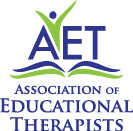![[image]](/images/become_ET.JPG)
AET sets the standards for the practice of educational therapy. Because there is currently no state licensure for educational therapy, the best way for educational therapists to demonstrate a high level of professional preparation and experience is to meet AET’s professional membership requirements. Use of the registered service mark of Educational Therapist/Professional (ET/P) or Board Certified Educational Therapist (BCET) provides educational therapists with a respected professional identity and assures the public of competency.
Three steps on the pathway to Board Certification:
Step 1: Become an Associate ET
- Meet the academic requirements.
- Complete coursework requirements though a university special education program or one of several online or residential Educational Therapy training programs.
- Document required courses included as part of a previously completed degree or credential program, such as a Master’s in special education.
- Ascertain eligibility for professional AET membership by comparing the course descriptions with those completed as part of earlier degree and credential programs. If most requirements appear to be met, the Membership Committee will review upon submission.
- Complete the Associate ET Application.
- Submit the application to the AET office along with:
- Academic transcripts
- Professional résumé
- Two letters of reference
- Application fee
- Submit the application to the AET office along with:
Step 2: Advance to Educational Therapist/Professional (ET/P)
- Document 1500 hours of direct service.
- Complete a period of mentorship/supervision with a Board Certified Educational Therapist (BCET).
- Achieve full professional membership.
Step 3: Become a Board Certified Educational Therapist (BCET)
- Complete additional experiential requirements.
- Document award of a Master’s degree in a related field.
- Pass the Case Study and Best Practices Exam requirements.
- Achieve the highest level of professional qualification.

![[banner]](/images/page-banners/inner-banner-08.jpg)
![[sponsor logo]](/templates/common/images/sponsors/westmark-school.jpg)
![[sponsor logo]](/templates/common/images/sponsors/charles-armstrong-school.jpg)
![[sponsor logo]](/templates/common/images/sponsors/mc-lean-school.jpg)
![[sponsor logo]](/templates/common/images/sponsors/ucsc-logo.jpg)
![[sponsor logo]](/templates/common/images/sponsors/schwab-logo.jpg)